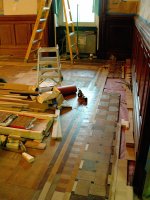My niche woodwhacking business built and installed custom millwork.
I've mentioned in the past that after a new hire showed he might be apt and stick around a while, he was issued a Stanley 60-1/2, or some preferred (asked for) the larger version, forget the #.
In the shop, there was very little smoothing unless it was by abrasives. In the field, there was all kinds of constant fitting, blending, and smoothing. Almost all done by the block planes with the throats set fine. (Or open when scribing long fits to walls, etc) . In the shop there was constant work leveling solid edge bands t & g'd onto plywood, or onto formica faces. The block planes were the fastest/most efficient tool to get things dead flush and smooth without tear-out, which even a little bit would ruin the part. On really difficult grain, things would be made close and finished with a few swipes of a scraper. But the close-mouthed, close-set block planes were pretty darn clean and efficient.
Since a lot of the work we made and installed was curved, i carried a 113 clone in the toolbox and used it constantly. Also, the longest Stanley plane that will fit in a standard carpenter toolbox is the #6, so that was the jointer and flattener for larger areas. Some rabbet planes, both iron and a few narrow wooden ones, and scrapers. I had a few flea market find Stanley bench planes, but almost never used them, certainly never carried the extra weight to jobs. I did have a few wood bottom transitionals that were used, some the bases were shaped including one for inside rounds of large staved/curved doors and such.
The close-set block planes did most of the work including smoothing of close installations. (Usually white oak, but also the range of domestic hardwoods). The iron & throat setting on the block planes could be adjusted to eliminate tearout, usually, even in very difficult grain, in positions where alternatives were difficult of inefficient. So that was what informed me when i started making planes. As others mention, infills are reputed to get a lot of their effect from a tight throat. Yet none had adjustable throats. So that was the important feature to add, when i made my first one. I've always included it since in any planes made here.
However, only a few years ago based on comments on OWWM, i started to explore using the cap-iron/chipbreaker as an alternate. I'm not settled that it is "better" than a close set throat, but it is certainly more maintainable for most people, long term. For smoothing, it seems it can work brilliantly, and would certainly be a necessary feature if one were making wooden body/sole planes.
I started trying the chipbreaker use more after making the adjustable bed angle plane. It has an adjustable throat, too, of course. But it was an opportunity to explore a little further.
Anyone try regrinding not only the sole but the frog as well. Then there is the question extension the frog sits on.
In the late 80's early 90's once i started using bench planes in the shop for furniture & building infill planes, I always scrape fitted those parts, and scraped the soles. *It is faster than surface grinding. A long time ago, i posted some of the process, including showing how surface grinding is inadequate, and slower. Typical plane castings are too flimsy to support and grind easily. AFA grinding in the areas to fit them, scraping is more accessible, though one does have to make or modify a few masters.
*scraping to flat is easier and more predictable to a good surface, and generally faster than surface grinding. A plane sole also benefits from different densities of flatness: most dense at the front of the throat, similar but not as critical behind. The toe gets all the wear, so it should be reasonably dense. The back part of the plane can be a lot more open/less dense. These effects can't be attained by grinding. OTOH to get an appearance finish does take a little longer. Grinding will make it pretty, pretty fast, if you don't bother to inspect it. Due to heat effects, grinding can easily make planes go hollow - which is the typical factory defect one is usually trying to correct in the first place. I've planed soles on the shaper. But still ended up scraping. I might try that again, though at some point, or actually set one up on the planer.


smt




